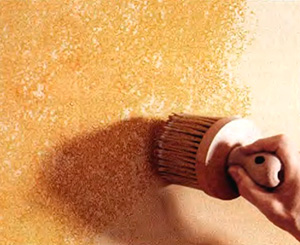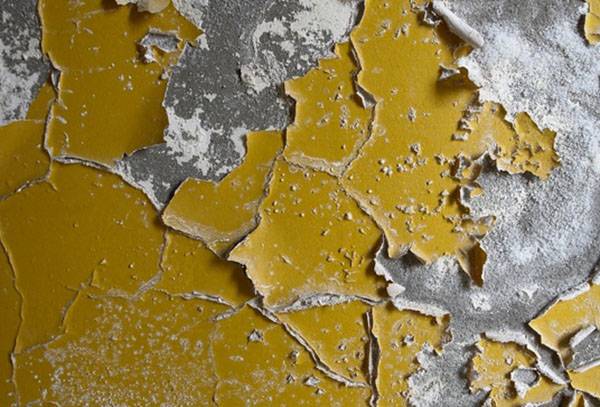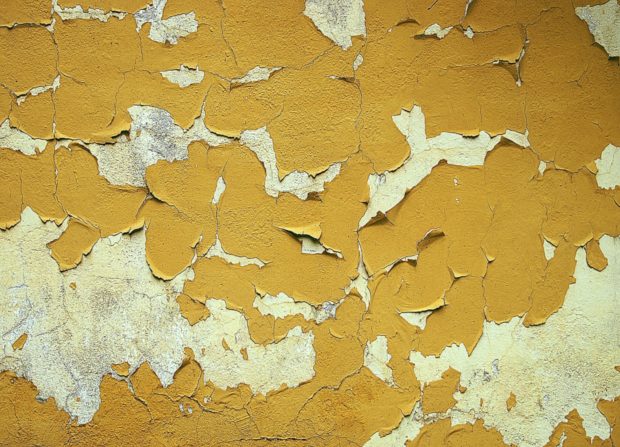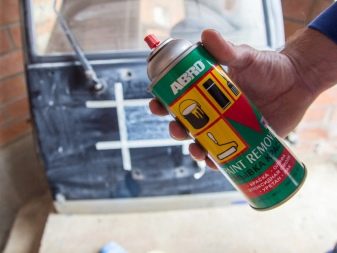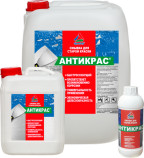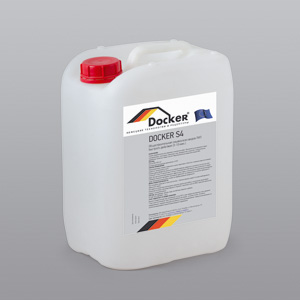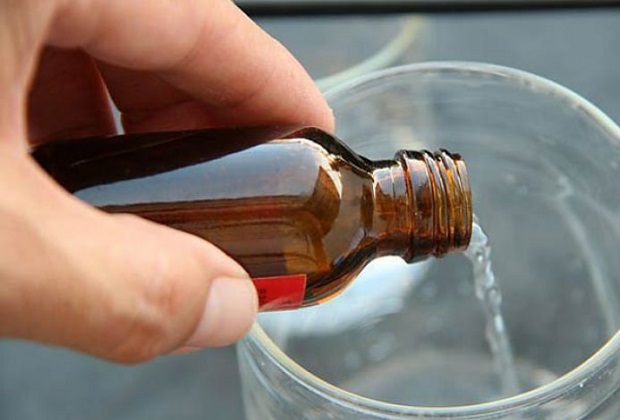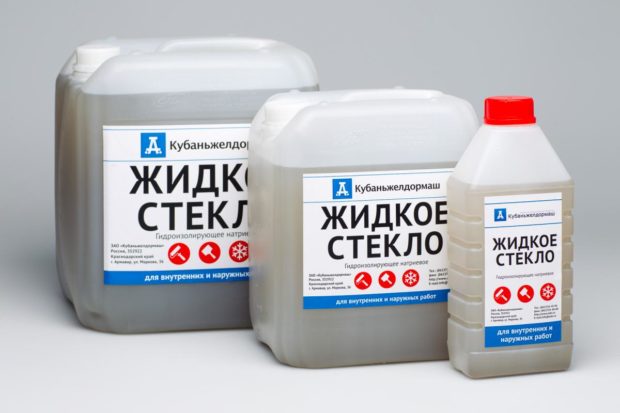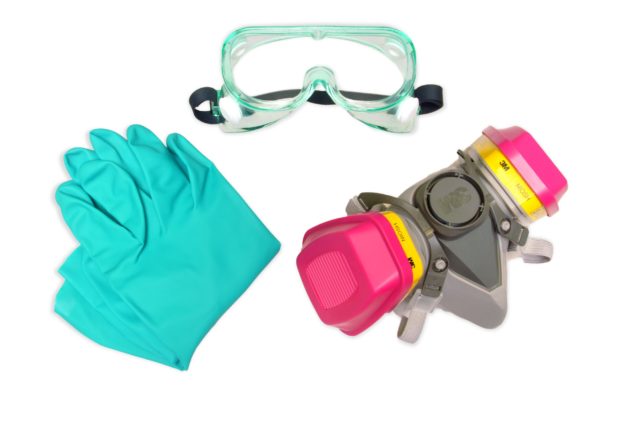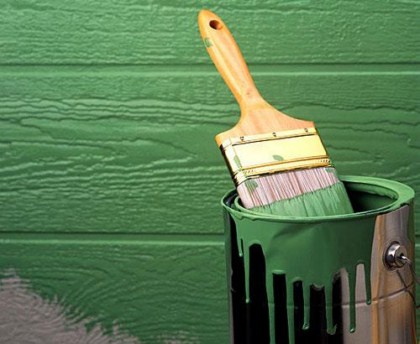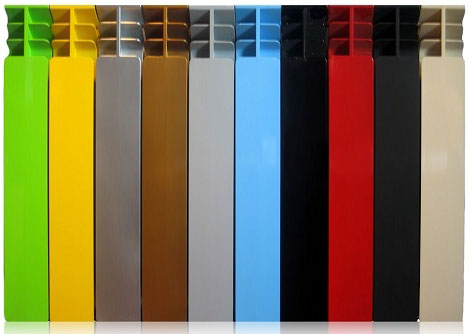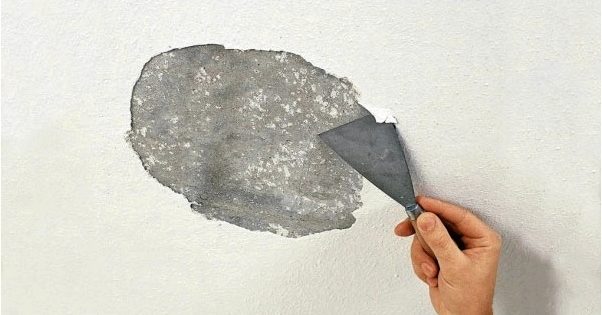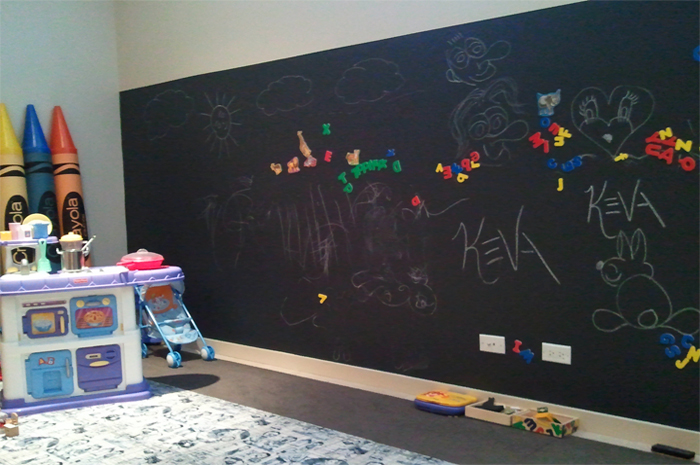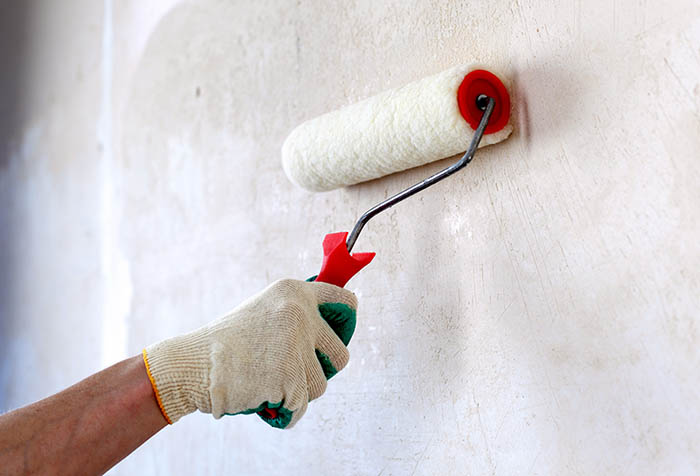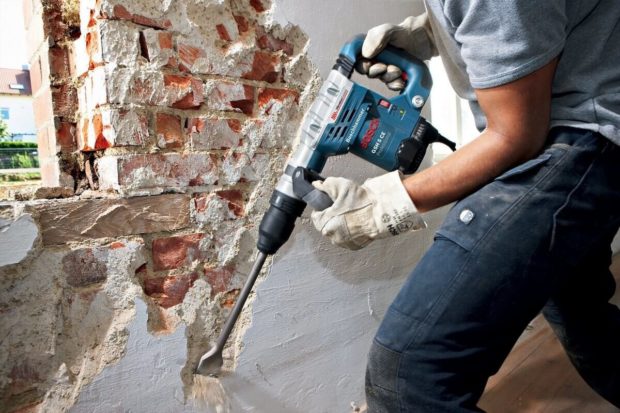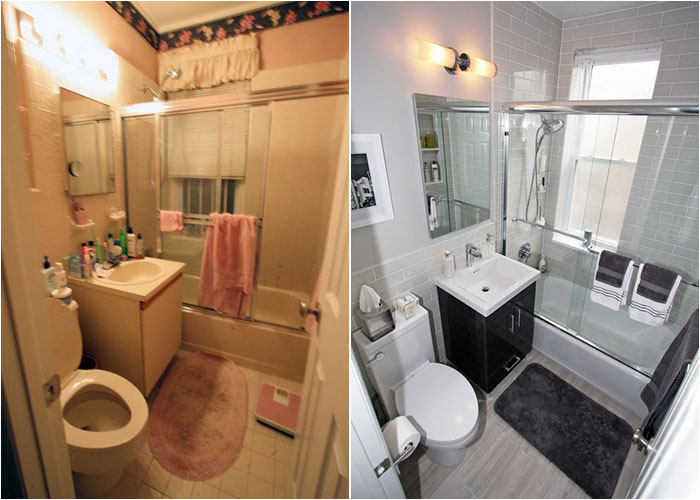10 ways to remove paint from a wall
Sooner or later, each owner of an apartment or their own home concludes that the time has come make repairs. It does not matter if it is a cosmetic procedure, the purpose of which will be to create a new and more fresh interior, or whether it will be a serious project, including re-planning and use of unusual finishing materials, you may encounter a number of difficulties. Especially if you intend to do all the work yourself. One of the most common problems is the removal of old decorative coatings from the walls. If the old layer plasters sometimes it starts to crumble and fall off in whole layers, and old wallpaper If they move away from the walls in whole strips, then it will be much more difficult to cope with a layer of old paint. And before a certain type of finish it must be removed without fail. In order to simplify this task, you need to know effective ways to remove paint from the wall.
When to remove old paint and why?
It’s no secret that 15-20 years ago, paint and paper wallpaper. Especially often you can find painted walls in the bathroom and toilet, in the kitchen or in the corridor. Creative builders often decorated the walls with flowers and boats. Unfortunately, such a print ceases to be touched when it becomes necessary to get rid of it. It’s one thing when the old paint is already half-finished and can be easily removed with a spatula. And it’s completely different when there are several layers, they are applied to the conscience and stick with enviable strength. Assuming the severity of future work, many drop their hands and creep in the thought: "or maybe him?».  We hasten to please you - in some cases old paint really no problem for further finishing work. It all depends on their type:
We hasten to please you - in some cases old paint really no problem for further finishing work. It all depends on their type:
- For example, when it comes to the bathroom, where there is a need leveling the walls for further installation facing tiles, you can simplify the task with drywall. Some walls are so curved and have such obvious differences that sometimes it is really faster and even more economical to level them with drywallfixed on profiles rather than using plaster. Plus you get a surface with excellent adhesive performance;
- For fixing plastic or other wall panels, lining old paint will not become an obstacle either;
- If re-staining is planned and the surface of the walls allows you to do without their alignment, you can apply a layer of a new coating on top of the old. Provided that it does not swell, does not exfoliate, holds tight and has no cracks. In some cases, it is allowed to remove certain areas of exfoliated paint, and fill the resulting unevenness with finishing plaster. But note this item applies only to situations when applied acrylic paint on an old acrylic, or enamel paint on an old oil. In the case of applying acrylic or water-based paint to an old enamel, these compositions simply will not “lie down” on a glossy surface. Perhaps when you apply it, it will seem to you that the paint was evenly distributed on the surface and everything turned out, but after drying you will find individual islands of a new color, which are interconnected by thin cobwebs;

- They will avoid the need for an old coating before tiling the walls and modern means. For example, a primer called Concrete contact and other interpretations of the name with a similar meaning promise good adhesion after drying, even with an absolutely smooth surface. The list even features glass, and on the Internet you can find many video confirmations.
- If you plan to apply wet plaster and other compounds to the walls, such as wallpaper glue, eg, paint must be removed without fail. Plaster simply does not “stick” to a smooth surface. The paint has a minimal ability to absorb liquid, so the usual soil simply can not penetrate into its structure and provide adhesion. And under the weight of heavy wallpaper, impregnated with glue, the paint can simply come off along with freshly glued wallpaper. Even if at first glance, it seems that she is holding tight.
What to consider when choosing a paint removal method?
Before embarking on laborious and lengthy work, it is necessary to understand what we are dealing with and try to choose a method that will nevertheless prove to be most effective with the least labor and time. To do this, you need to pay attention to five determining factors:
- Decide which amount of funds Are you ready to spend on acquiring the right tools or solutions, and are you ready at all?
- How time you have. After all, it happens that the employee whom you hired to lay the same tile is suddenly released earlier than the agreed time and is ready to start work at your place in a day. Then you have to prepare the walls at a very fast pace;
- An important role is played by type of base. It could be plaster, cementbrick or concrete;

- A type paints - acrylic, water emulsion, oil or enamel. Of course, it is very difficult to do this with a visual inspection, but it is still possible to distinguish the oil composition from others. We must say right away that the most difficult will be the removal of oil paint from the concrete base;
- And the last - number of layers paintwork. A thin layer is sometimes much more difficult to remove than a thick layer, which, when struck, breaks off with plates due to its own rigidity.

And the best thing is to "try for a tooth" and try to remove a piece of paint in each of the methods one at a time on a small section of the wall, starting with the simplest.
Mechanical methods for removing paint
Usually, they primarily try to remove the coating mechanically. It should be noted right away that these methods are the most time-consuming, but at the same time one of the most affordable. A variety of tools are used, starting from the simplest. Before starting work, it is necessary, if possible, to free the room from furniture or cover with a film surfaces that should remain clean and not dust and particles of paint. Let's consider in more detail.
No. 1. With a spatula
This is the very first tool with which there is a desire to scrape off peeling paint. A spatula will definitely be found in almost any home. Advantage the method consists in the complete absence of dust and in the fact that it is possible to remove paint even in corners and other inaccessible places - around switches or sockets. TO disadvantages relate to the relatively slow speed of work, the need to make considerable efforts and the inability to cover a large surface area in one approach. During operation, small particles of paint break off and can get into the eyes, thereby injuring them. Therefore, be sure to think about personal protective equipment. This rule applies to all absolutely methods of removing old coatings.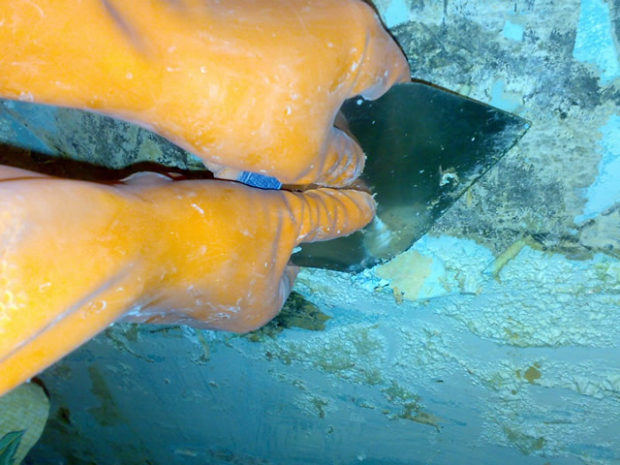
No. 2. At relief chisels and a hammer
When you reach a section of the wall where there are no cracks and swelling of the paint and the spatula is already powerless, you can try to remove it with a chisel. It does not bend during operation, unlike a spatula, and if necessary, you can tap on its handle with a hammer. It is necessary to sharpen the tool from time to time. It will quickly dull from constant friction on a hard surface.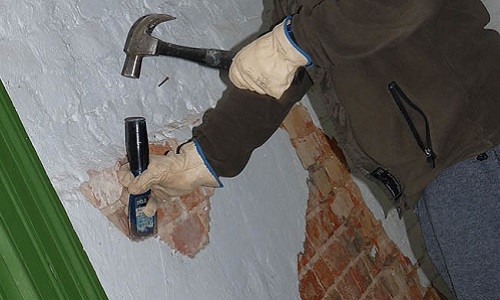
No. 3. With an ax or pimples
This method is incredibly time consuming. You will have to wave the ax for a long time, so we advise you to choose a tool that is not too heavy. However, it should not be too sharp. The essence of the method is to apply notches to the wall. Impacts should be tangent to the wall. The length of the notches can reach several centimeters, and they should be located at a distance of no more than 10 mm from each other. Only on such a surface will it lie completely reliably putty or adhesive. But the main disadvantage The method actually lies a little deeper. Think about how many blows you have to strike against the wall and understand that each of them will gradually violate the integrity of the foundation that you want to get rid of the hated paint. Not all walls can withstand such torture and remain strong and reliable.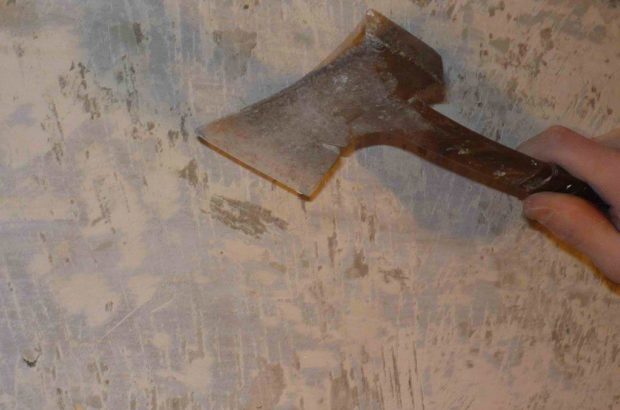
Number 4. With a drill with various nozzles
This method can be called optimal by the ratio of performance and safety. Plus, due to the fact that drill - This is not the hardest hand tool, hands will get much less tired during work. Security achieved due to the fact that the work is performed at low speeds. Before starting, be sure to check the operability of the tools - if the wire is broken, if the cartridge holds well, if the device sparks. In order not to be distracted by trifles, make sure that the cord length is sufficient for free movement along the entire length of the room, use an extension cord. Be sure to wear a face shield, covered clothing and shoes, and a hat. Never leave your sleeves unfastened or wear gloves. When working with revolving tools, their use is also unacceptable - the reliability of fixing the tool in your hand deteriorates and you simply can not hold it. In the best case, the instrument itself will suffer if it falls, and in the worst case, it will injure the performer.
Now you need to adjust the speed of revolutions - turn on the drill without a nozzle and select the minimum mode. Now fasten the nozzle, tighten the cartridge well and get to work. It is only necessary to touch the wall with the surface of the nozzle and not move too quickly. Most often use a metal brush. But in practice, it is less effective than a nozzle in the form of several connected chains of 3-4 links with a washer at the ends. In addition, sometimes metal bristles come off and can dig into unprotected areas of the skin;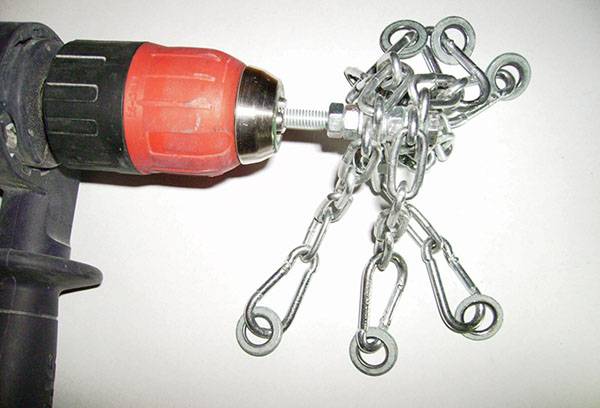
No. 5. Using a grinder
This method can be called the fastest and at the same time the most dangerous. Bulgarian relate to high speed tools. In the absence of skills to work with her, you can be seriously injured. No one is safe from the destruction of the disk during operation, the fragments of which fly at an incredible speed in different directions. The disadvantages include a high noise level, and a huge amount of dust. The work is usually carried out using a wide range.
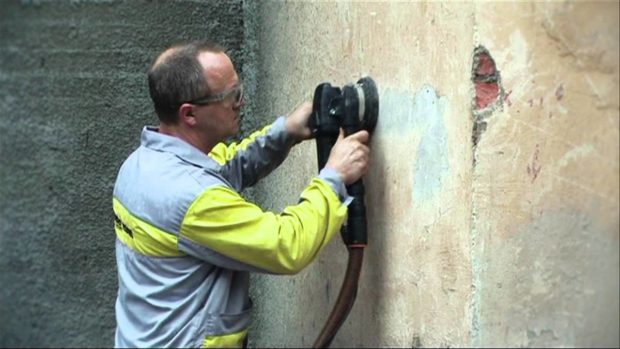
To summarize we can say that mechanical methods are suitable for removing paint of absolutely any type - both acrylic and oil. It’s just that some of them will need to be periodically moistened, and then also removed with a spatula, wire brush or power tool.
Thermal methods
Methods for removing old paint using elevated temperatures also carry to extremely dangerous. When carrying out such work, reliable protection and concentration are necessary, and, of course, experience with the tool below. Three commonly used methods can be distinguished.
No. 6. We use an ordinary iron
For a coating that is no longer held in the most reliable way, the method of exposure to temperature is suitable with help the usual iron. Through a sheet of dense foil, it is possible food, the desired area is well heated, and then the softened coating is removed with a spatula.
Number 7. We use a building hair dryer
Similarly, only much faster can paint be “melted” with help building hair dryer and then remove with the same spatula or other convenient scraper.
Number 8. Blowtorch method
Sometimes apply a blowtorch. Or in other words, a burner that runs on kerosene or gasoline vapor. One liter of fuel on average is enough for continuous operation for 20-50 minutes. The flame must be brought as close to the paint as possible and carefully watched. When the paint begins to melt, but does not burn, you can scrape it off the wall.
All thermal methods required accompanied by a sharp and unpleasant smell which appears during the heating of the paint. Therefore, it is strongly not recommended to work in unventilated rooms. Also by no means not allowed warm places where pass electric wires or those with wooden mortgages in the wall.
Chemical methods
Methods for removing old coatings with chemicals can be called least time consuming. You only need to carefully distribute the product on the surface, let it work on the paint for the recommended time, and then remove the softened coating. 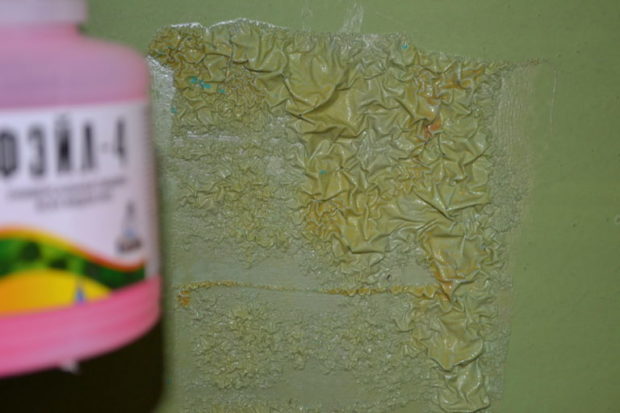
No. 9. Ready paint remover
The time interval is always indicated on the packaging, as well as recommendations for use, which we advise to adhere to in strict order.
- All chemicals have pungent odors and are highly aggressive. Be sure to work with gloves and a respirator, and for the duration of the solution it is better to completely leave the apartment, opening the windows for ventilation;
- Also, after finishing work, you can’t just take and pour the remaining solution into the sewer. Chemicals are very corrosive and should disposed of properly. This is also mentioned on the packaging or in the instructions;
- Can scare away and cost such tools, but believe me, after you try to remove the paint with a spatula, ax or grinder and none of the above will give the desired result, you will not want to save. Often, one liter of solution is enough to remove paint from the walls of the bathroom and toilet in standard sizes;
- Pay attention to the fact that some formulations may be intended for use only on horizontal surfaces.
IN component dependent Basics ready-made compounds are:
- Acidic - based on hydrochloric or phosphoric acid;
- Alkaline - based on salts of various origins;
- Organic - which do not contain salts or acids.
To remove old paint from a stone surface most suitable acid-free compounds are considered. 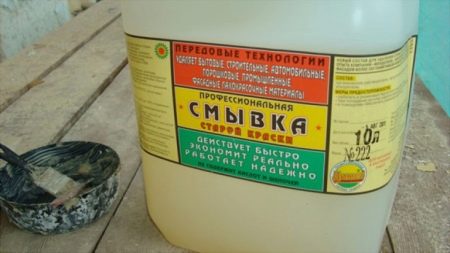
According to the form of release solutions can be in the form of:
- Liquids - alkaline or acid concentrates to be diluted;
- Gels - have a milder effect and are available on the basis of organic compounds.More convenient for use indoors, as they do not have such a pungent odor;
- Powders - are used both in the form of solutions and independently;
- Aerosol - designed to work with small areas and are very convenient.

To choose the composition for a certain type of paint is not difficult. In order not to make a mistake in choosing a wash, better to buy universal solutions that are suitable for removing paints of any type. For instance:
- Flushing Fail 5 - It is designed specifically to remove old paint and dissolves even powder formulations. It begins to act a few minutes after application. You will see how the old coating begins to become covered with small cracks;

- "Anticras" - universal high-speed wash suitable for removing paint not only from walls, but also from the floor, stream, metal, wood, plastic;

- "Docker S4 "is a general construction wash used to remove all types of paintwork.

No. 10. How to make a do-it-yourself wash?
Still, you can try to save and prepare a wash for paint independently:
- It is necessary to mix 250 ml of ammonia with a liter of cold water. Alcohol should be 10%. In the resulting liquid, you need to add 2 kg of ordinary chalk and mix thoroughly until a pasty mixture is formed without lumps. The resulting slurry is applied to the wall in an even layer. After a couple of hours, you can begin to remove the paint. Such a composition should not destroy the paint layer itself, but violate the strength of its adhesion to the base material;

- Another popular method is to mix 1.2 kg of quicklime with 400 g of soda ash, then add water. The mixture should resemble thick sour cream in consistency. It is applied to the wall for a minimum of 12 hours;
- You can use liquid glass. It is applied in a thin layer over old paint. After drying, a thin silicate film forms, which should peel off with the paint.

Typically, the above methods do a good job of either removing the recently applied or decrepit coating. For strong layers of paint, it is better to use ready-made, special washes.
Wash technology
When the choice of the right remedy is made, it’s time to deal with the right technology his application:
- For the most effective and deep penetration of the reagent into the layer of old paint, the surface must be rid of dust and other contaminants. You can wash the walls using household chemicals, and then rub them with a stiff brush or coarse sandpaper;

- Now apply the chemical composition itself. This should be done with wide brush or roller. Do not wet them too much so that the product drains or drips onto the floor. It is better to direct movements in one direction;
- So that the reagent does not so quickly evaporate from the surface and manage to exert a proper effect on it, it is possible to cover the surface with a film. Doing this, of course, is necessary with gloves on;

- After the recommended time, remove the film and remove the paint;
- In the end, you need to wash off the reagent from the wall and neutralize its effect. Recommendations on this subject must indicate the manufacturer.
That's all, your walls are ready for further transformation. If one of the above methods does not give a full effect, try combining it with other methods. By and large, they are all suitable for removing any kind of paint.

